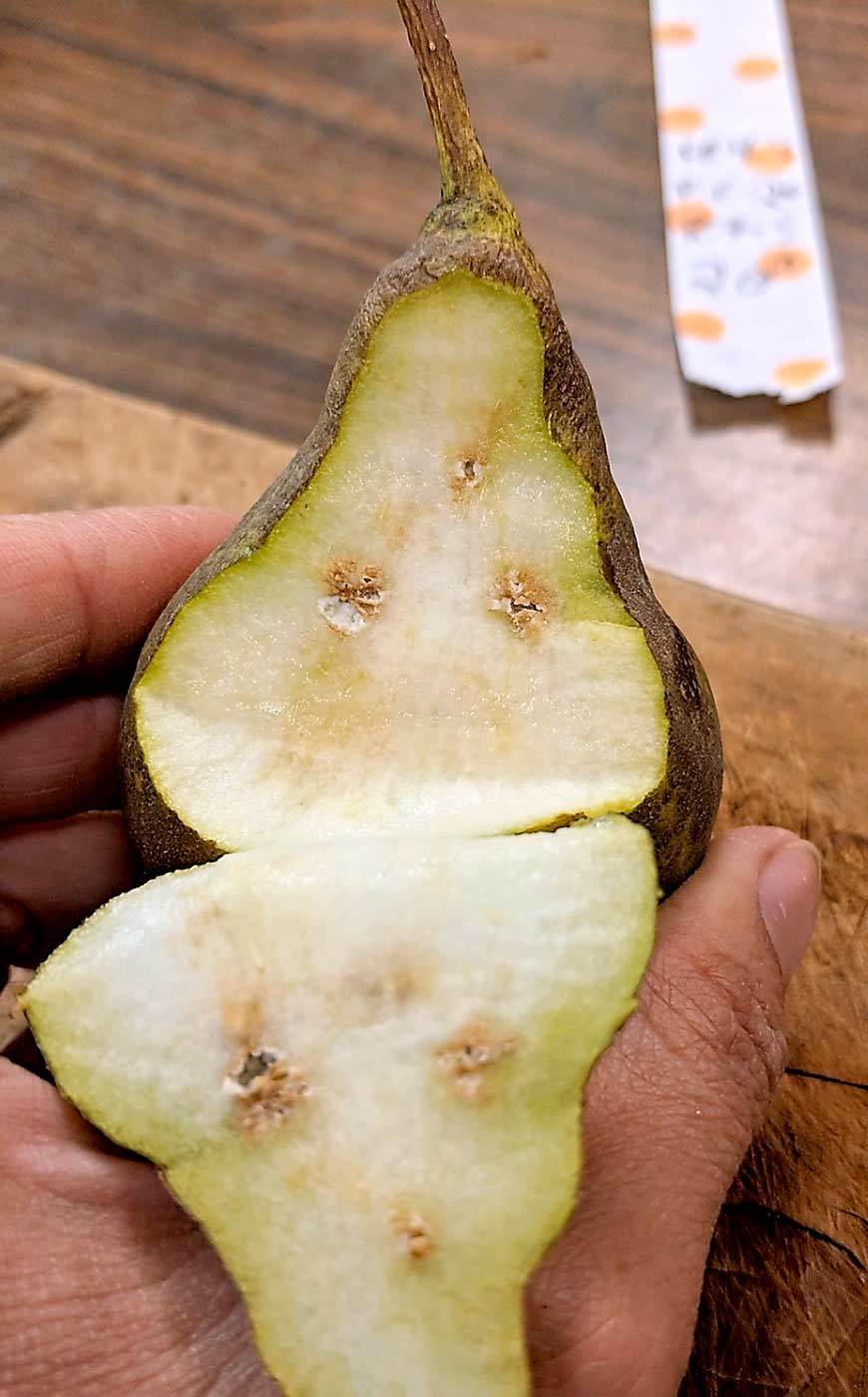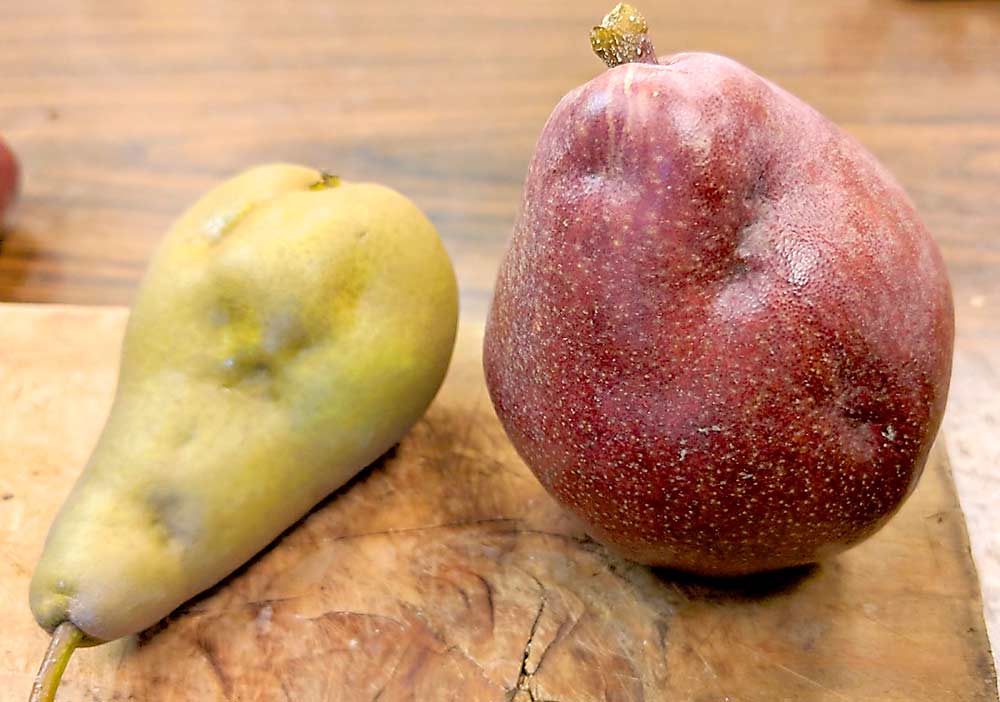
Brown marmorated stink bugs really like pears. And cherries. And hazelnuts.
So, as BMSB naturalizes in many of Oregon’s extra-orchard landscapes, growers face a new pest pressure and plenty of unknowns.
“We’re sort of behind the situation back East and we’ve been using that information to prepare here,” said Rick Hilton, an Oregon State University entomologist based in Medford. “But back East, there aren’t many pears grown and there certainly aren’t any hazelnuts.”
Ideally, management would reduce stink bug damage without introducing too many blanket, broad spectrum sprays that put integrated pest management approaches in jeopardy, but the difficult-to-predict pest poses a challenge when it comes to using monitoring traps to predict damage.
“We’re trying to use some of the techniques that have been established on the East Coast, but this is a different cropping system with a different surrounding ecosystem,” said Chris Adams, an entomologist who joined the OSU Mid-Columbia Agricultural Research and Extension Center late last year. “I’m afraid we are going to have our own learning curve here.”
Linked to landscape
BMSB first popped up in Oregon in 2004, but the past two years have been a turning point in terms of its threat to specialty crops, said Nik Wiman, an OSU entomologist based in the Willamette Valley.
“Initially, we were first working with it in urban areas, but now it’s crossed a threshold where it’s become naturalized,” he said. “We have a lot of areas of orchard crops that are bordered with natural vegetation, and some of the trees in those remnant natural forest borders are really good hosts for the stink bug.”
That certainly seems to be part of the problem for pear growers in the White Salmon area in the Columbia Gorge, said OSU extension specialist Ashley Thompson. White Salmon is in Washington, but often monitored by OSU as part of the Columbia Gorge growing area. The first economic damage occurred in 2018, and last year it was even worse, she said. It may even be underestimated, because the feeding damage can look similar to cork spot.
“About 50 percent of the cull you think is cork spot is likely stink bug — that’s what we are hearing from the packing houses,” she said.
Early-season feeding, when the pears are still quite hard, can result in fruit deformities similar to those caused by stony pit, a virus that’s common in older Bosc blocks but rare in newer plantings, she said.

Orchards surrounded by riparian forest — including bigleaf maples that appear to be a particular BMSB favorite — put the White Salmon growers at high risk.
“The challenge with stink bugs is that it can build up its numbers on wild hosts and then come into your orchard continually,” Adams said. That’s led some researchers to promote perimeter spray techniques, but he’s not sure that approach will work in White Salmon.
“Stink bugs are probably raining down from the hills and tree tops, due to the difference in topography,” he said.
In Medford, the worst spot for BMSB is a block at the OSU research orchard next to a riparian woodland, Hilton said. The untreated trees in his research trial there showed “extremely high levels of damage,” he said.
For cherry growers, the surrounding landscape may offer an advantage. Growers in The Dalles have not reported BMSB problems, Thompson said, while in the Willamette, Wiman reports that cherries are targeted by the overwintering adults. Like peaches in the East, cherries and almonds appear to be really good hosts.
“The one advantage the cherry industry has is that most of the production is in the desert,” he said.
Trap trouble
When Wiman used monitoring traps in Willamette cherry orchards, he encountered a problem. The commercial BMSB lures use an aggregation pheromone that doesn’t seem as effective in the spring — when the stink bugs are dispersing and looking for hosts — as it is in the fall when they aggregate before overwintering, he said.
“So, for an early-season crop such as cherries, that early season when you need the traps to be working, you can’t expect enough catch,” he said. He set up a trial to find the relationship between trap catch and damage for cherries, pears and hazelnuts, and found a negative relationship.
“In my opinion, we have a long way to go to understand how we can use these traps in management,” he said. He recommends a sticky-card trap, paired with the lure, for detection, in natural vegetation outside the orchard.
In the Mid-Atlantic U.S., researchers developed trap-catch, threshold-based spray recommendations, but Wiman doesn’t think that approach will work best in the Pacific Northwest because it results in growers spraying insecticides at a much greater frequency.
“We have a lot more to lose by increasing our spray intervals up to that level,” he said. “There’s so much at stake in the IPM systems that are in place that we don’t want to lose with pyrethroid sprays against stink bugs.”
But with pest pressure rising, growers need solutions. Wiman believes the parasitoid samurai wasp offers the best long-term control option for the pest across the landscape. In the meantime, he’s interested in the potential of spray timing to target nymphs and the repellent effect of particle films or exclusion netting, which Betsy Beers at Washington State University has found beneficial. She’s also tested intriguing attract-and-kill systems that combine the lure with insecticidal netting — but luring a lot of stink bugs to their death doesn’t necessarily reduce orchard damage.
Adams plans to trial that approach, and others, in the Mid-Columbia area this season.
“We’re going to try every idea that’s remotely possible to see if we can make a difference for these growers out here,” he said.
The good news: Growers and field reps in the regions are on the lookout for BMSB damage, so they won’t be blindsided like Eastern growers were back in 2010, Hilton said.
“We’re really just trying to forewarn everyone so we don’t get caught off guard,” he said. •
—by Kate Prengaman






Leave A Comment